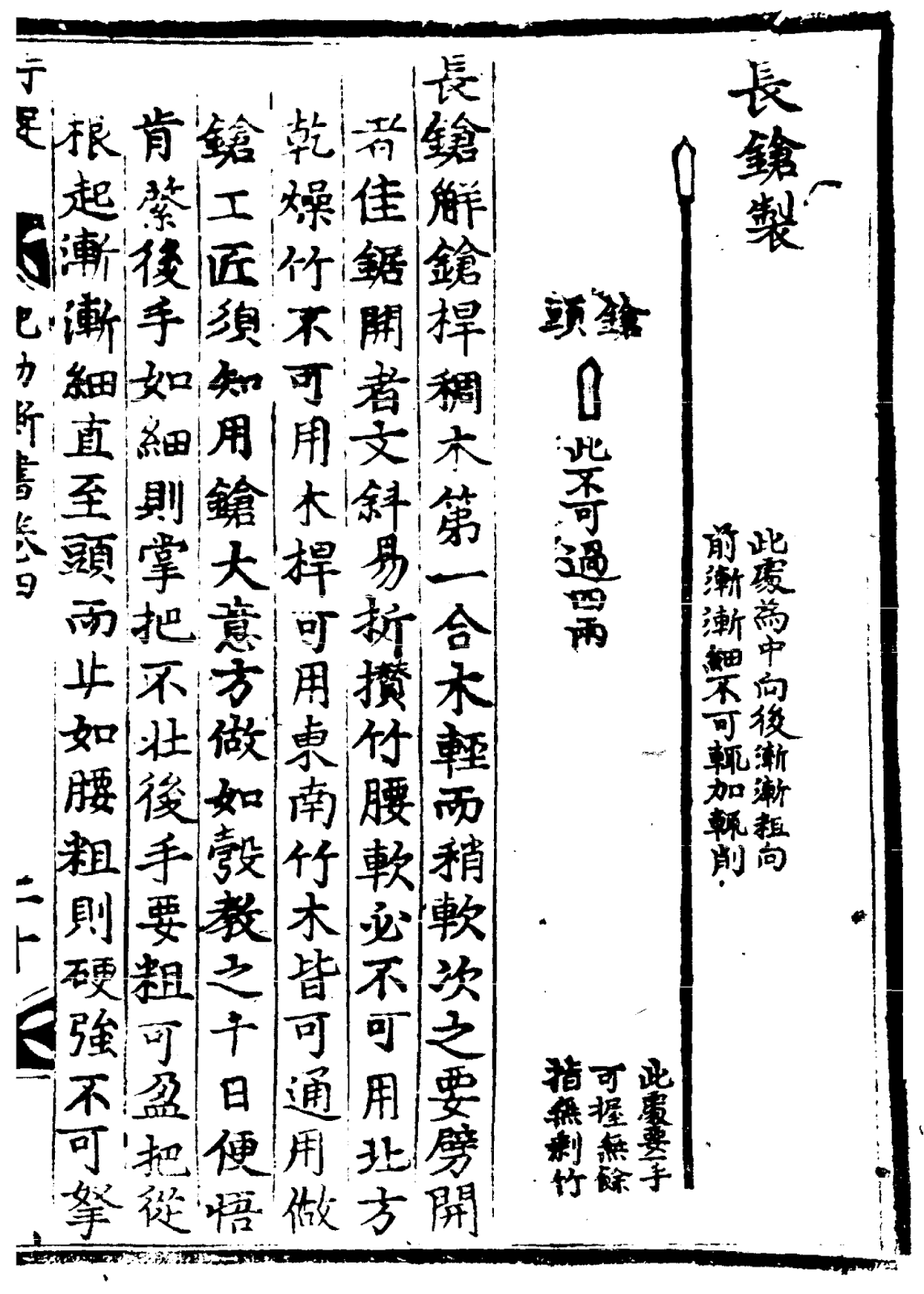 |
| Drawing of a Chang Qiang, from 'Ji Xiao Xin Shu (《紀效新書》)'. |
A Chang Qiang (長鎗, long spear) is a very long weapon. In fact, it is the longest melee weapon in the Ming arsenal, longer than all other types of Chinese spear it replaced. It is effectively the Chinese equivalent of pike. The shaft of a Chang Qiang can be made of either wood or bamboo. Bamboo Chang Qiang can be made significantly longer than the wooden version, reaching as long as two
zhang four
chi in length. However, bamboo shaft is generally softer, less durable, and very hard to parry with.
 |
| Different variations of Chang Qiang, from 'Wu Bei Zhi (《武備志》)'. |
Chang Qiang of the early Ming period was only one
zhang three
chi in length. It gradually became longer during mid to late Ming period, with one
zhang five
chi to one
zhang eight
chi Chang Qiang being the most common.
 |
| Chang Qiang training manual, from 'Ji Xiao Xin Shu (《紀效新書》)'. |
Chinese pikemen held their Chang Qiang close to the hinder end in order to maximise the advantage of long reach. When facing a cavalry charge, Chinese pikemen did not utilise the "charge for horse" bracing posture like European pikemen, settling for a more simple kneeling position instead. They often worked together with
Lang Xian (狼筅) or used
cheval de frise to fend off the horsemen.






Hi,
ReplyDeleteI think you should consider adding 《手臂錄》in this section and the surviving marital arts manual.
Hi, I put it in the “surviving Ming period martial arts” section of this blog.
DeleteRegarding the tassel on Chinese spears. In martial arts circles they call it the "blood guard" supposedly used to soak up blood that can run down the shaft. Or some argue it could be used for distraction.
ReplyDeleteOne thing crossed my mind though, Chinese spearheads are usually socketed. Could the tuff of horsehair be actually used as a extra fitting material to hold the socket more snugly? Has any Ming era spear manual mention by any chance?
The tassel is probably just there for the looks, and serves no practical purpose.
DeleteUnlike the short and wobbly wushu spears, military spears are very long, so the scenario of enemy blood flowing down the shaft will not be very realistic. Military spears are also stiff, so it will be very tiresome to wave around the spear/tassel for distraction.
Chinese had other means to secure the spear socket, for example jamming a nail (or several) horizontally through the socket and into the shaft. I don't think tassel was used for that purpose.
Did they not use shields with their pikes? That sounds like arrow fodder to me
ReplyDeleteYes, they didn't use shield with their pikes. And yes, they would be arrow fodders.
DeleteThat didn't stop soldiers from all over the world from using two-handed weapons without shields though. Swiss mercenaries, Landsknechts, samurai, nearly everyone in the 17~19th century, huscarls, English billmen...there are just too many to list.
Actually, warrior from the yunnan region did in fact used large round shield with a flap extending from it to defend the legs. Here are some early 20th century pictures of it. Considering the lack of change in arms and armor of yunnan since the 13th century,I assume they were used in the ming dynasty. https://pin.it/3bpe7srlfkoct2https://pin.it/3bpe7srlfkoct2
Deletehttps://pin.it/2jeepgt4246izs
Did the Chinese spears usually have butt spikes and/or butt caps?
ReplyDeleteVaries.
DeleteYou won't see them much on very long Ming pikes, but shorter spears usually have butt spikes. Likewise Qing regulation military spears and pikes all have butt cap/spikes, and there are quite a few surviving spears with them.However spears used by militias (and show up in late Qing/Republican old photos) frequently don't have anything.